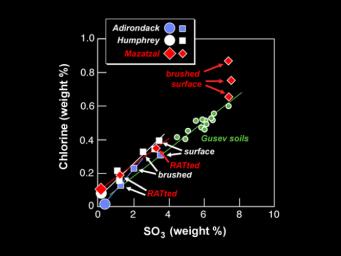
|
Outer Appearances Can Be Deceiving
- Click the image above for a larger view
- Full-Res JPEG (720 x 540) (34.2 kB)
- Full-Res TIFF (720 x 540) (137.9 kB)
Caption:
This graph shows the chemical composition of the rock at Gusev Craterdubbed "Mazatzal" after it was brushed and ground by the Mars ExplorationRover Spirit's rock abrasion tool. The data, taken by the rover's alphaparticle X-ray spectrometer over the last few sols, show that the amountof chlorine and sulfur tri-oxide in Mazatzal first increased afterbrushing, then diminished after grinding. The interior of the rock appears tohave the same chemical make-up as other volcanic or basalt rocks studiedin the Gusev Crater area ("Adirondack" and "Humphrey"). Its outer coatingor rind, on the other hand, appears to be of a different constitution.Scientists are still puzzling out the implications of these data.
The larger symbols on the graph represent inferred rock compositions,while the smaller symbols are actual data points. Observations were madeat the target dubbed "New York" on Mazatzal.
Cataloging Keywords:
| Name | Value | Additional Values |
|---|---|---|
| Target | Mars | |
| System | ||
| Target Type | Planet | |
| Mission | Mars Exploration Rover (MER) | Mars Science Laboratory (MSL) |
| Instrument Host | Spirit (MER-A) | Curiosity Rover |
| Host Type | Rover | |
| Instrument | Alpha Particle X-Ray Spectrometer (APXS) | Rock Abrasion Tool (RAT) |
| Detector | ||
| Extra Keywords | Color, Crater, Volcano | |
| Acquisition Date | ||
| Release Date | 2004-04-01 | |
| Date in Caption | ||
| Image Credit | NASA/JPL/Cornell/Max Planck Institute | |
| Source | photojournal.jpl.nasa.gov/catalog/PIA05674 | |
| Identifier | PIA05674 | |
